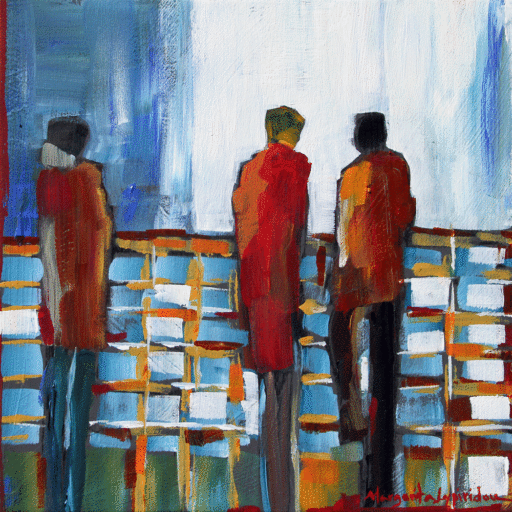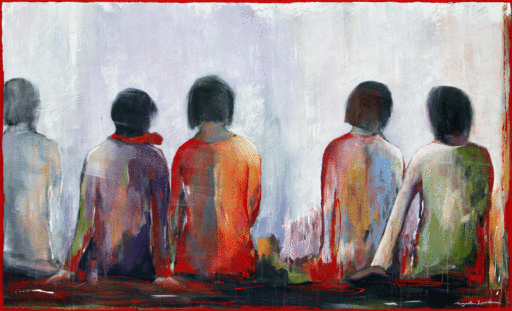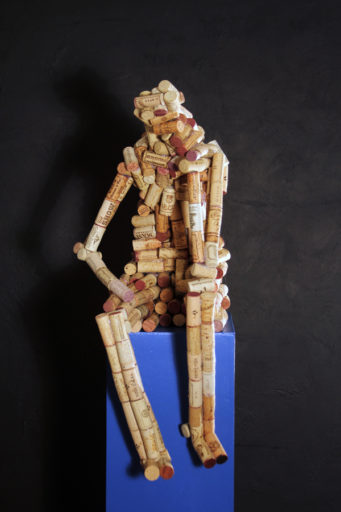Opening
Exhibition
Affinities
When I first encountered and wrote about Margarita Lypiridou’s paintings six years ago, I was struck by her fragmented, uncanny cityscapes peopled by
ethereal, floating figures. Though rarely completely absent from her urban scenes, these were evocations rather than illustrations of people, their anatomy often reduced to a megalith shaped body upon which balanced a smooth, oval head. Painted in hues identical to their surroundings, they became part of the landscape, bleeding into the shifting, ominous cities in which they found themselves.
In the artist’s latest series, Affinities, it is as if our perspective has zoomed in, leaving behind the sketchy grid of building and streets and focusing on those figures: the slab-like bodies become lean and graceful, the oval heads acquire a dark sweep of short, windblown hair. However, their anonymity lingers: they remain turned away from the viewer, absorbed by a view of a distant city skyline (Un spectacle), a blazing emergence of sunshine (From Rain to Sunshine) or the myriad blues of the sea (Thalassa). Like Caspar David Friedrich’s lonely Romantic figures witnessing the sublime in nature, Lypiridou’s figures become surrogates for the viewer, their anonymity allowing us both to become them while also keeping us at a distance, simultaneously intimate and yet unknowable.
At first glance, we become conscious of the structural resemblance – the affinity – of these figures to each other. Traditional markers of difference, such as gender, colour, body shape, and clothing are minimized: with the exception of a flapping scarf or fluttery spray of skirt, these figures almost seem like iterations of the same person. Through brushstrokes that are alternately sweeping and loose (Affinités) or blocklike and choppy (Casual Talk), Lypiridou suggests a fundamental similarity between these figures. In works like Vingt, Breathing Space, and Ascension, we can easily imagine the rows of these anonymous, virtually identical figures marching into infinity: human beings as undifferentiated collectivity.
The closer we look, however, the more this initial resemblance becomes complicated by other forces. With no facial expressions to read, the body language and placement of these figures is brought vividly to the fore. We become keenly aware of who stands together and who alone, which figures lean into each other and which allow a meandering strip of background to push them apart (see especially La possibilité and Breathing Space). Each subtle gesture becomes charged with significance and meaning. Moreover, while at the structural level they are built up with the same brushstrokes, the richness and complexity of the relationships between these figures is suggested by the more superficial layers of paint added by the artist: fluid drips, a flurry of scratches, spontaneous sprays, and a sweeping, almost transparent veneer of white that suffuses these canvasses with a movement we can feel more than see, like a wind whistling through and around these figures.
The twofold meaning of the title of this series is revealed here, for “affinity” refers both to a deep structural resemblance and a spontaneous attraction to or liking for someone or something: when we feel strongly drawn to another without really knowing why. The forces that sweep human beings together or drive them apart is suggested by the variety of Lypiridou’s brushstrokes, transforming these seemingly anonymous figures into distinct individuals. This oscillation between the familiar and mysterious is at the very centre of human relationships: no matter how much we love, need, and know a person, they remain stubbornly, beautifully, separate from ourselves. The paintings in this series allude to the complex, shifting nature of our relationship to the other and speak to the seemingly contradictory essence of the human condition: we are social animals, drawn to and defined by others, and yet essentially and always alone.
Avery Larose – Art Historian







